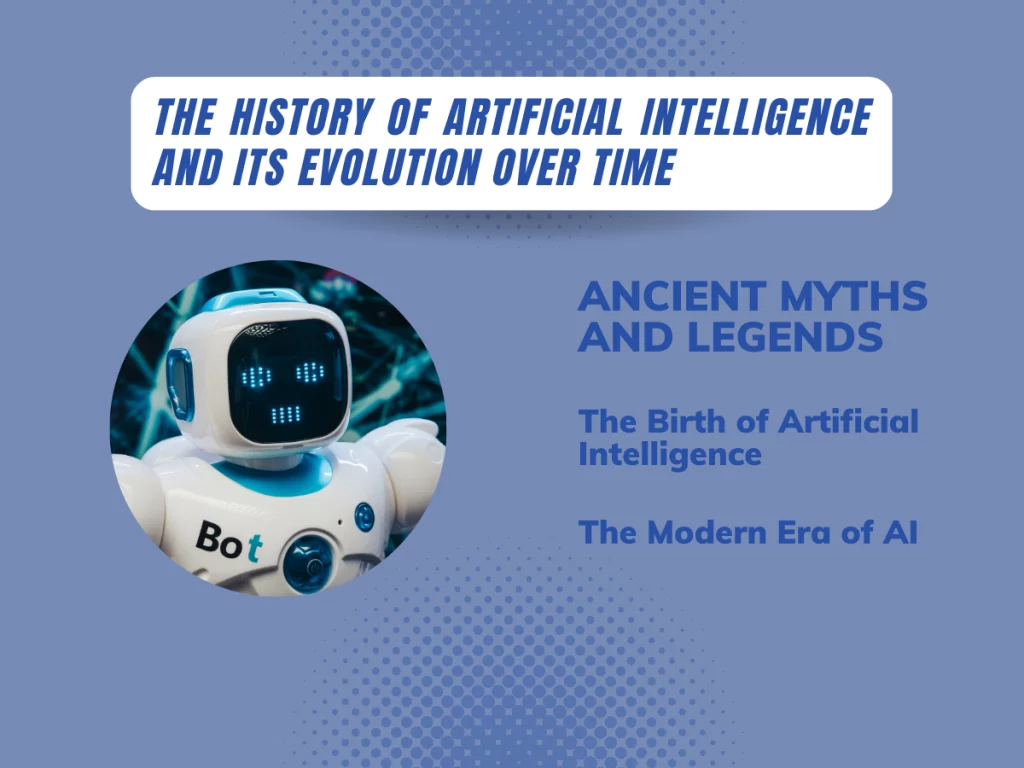
Artificial Intelligence (AI) is one of the most fascinating and rapidly developing fields of modern technology. It encompasses a broad range of applications, from voice assistants to self-driving cars, and promises to revolutionize the way we live, work, and interact with the world around us. But where did it all begin? What is the history of Artificial Intelligence and how has the evolution of AI happened over time?
In this article, we’ll take a deep dive into the fascinating history of Artificial Intelligence, from its early origins in ancient myths and legends to its current state of the art. We’ll explore the key milestones, innovations, and challenges that have shaped its journey from fiction to reality.
The history of AI and the evolution of AI over time
Ancient Myths and Legends
The idea of creating artificial beings that could think and act like humans date back to ancient myths and legends. For example, in Greek mythology, Hephaestus, the god of fire and metalworking, created Talos, a giant bronze statue that could move and speak. In Jewish folklore, the golem was a humanoid creature made of clay and brought to life through mystical incantations.
These stories illustrate a deep human desire to create beings that could think, reason, and communicate like humans. However, it wasn’t until the 20th century that technology began to catch up with this vision.
The Birth of Artificial Intelligence
The birth of AI can be traced back to the seminal work of British mathematician and logician Alan Turing in the 1930s. Alan Turing postulated the concept of a “universal machine,” capable of executing any task that a human computer could perform. Additionally, he formulated an assessment, presently recognized as the Turing test, to assess whether a machine could exhibit intelligent conduct that was indistinguishable from that of a human being.
In the ensuing decades, researchers and engineers embarked on constructing rudimentary AI systems that could execute fundamental assignments, such as playing chess and resolving mathematical conundrums. These systems were founded on rule-based expert systems that utilized a collection of pre-established protocols to formulate resolutions and draw inferences.
The Rise of Machine Learning
In the 1950s and 1960s, a new approach to AI emerged: machine learning. This involved developing algorithms that could learn from data and improve their performance over time. One of the key breakthroughs in this field was the development of the perceptron algorithm by Frank Rosenblatt, which could learn to recognize patterns in images and other data.
In the 1970s and 1980s, the field of AI experienced a surge of interest and investment, fueled by the rise of powerful new computers and the availability of large datasets. Researchers developed new techniques for machine learning, such as neural networks and decision trees, that allowed machines to learn and reason in more complex ways.
The AI Winter
However, this rapid progress came to a halt in the 1990s, as AI suffered a major setback known as the “AI Winter.” This was caused by a combination of factors, including the failure of early AI systems to live up to their hype, a lack of funding, and the rise of alternative technologies such as expert systems and fuzzy logic.
For nearly a decade, AI research languished in relative obscurity, until a new breakthrough in the early 2000s reignited interest in the field.
The Modern Era of AI
Today, AI is once again at the forefront of technological innovation, with new breakthroughs and applications emerging on a regular basis. The present phase of artificial intelligence (AI) is characterized by a resurging concentration on machine learning, particularly deep learning. Deep learning is a division of machine learning that employs artificial neural networks to learn from extensive datasets and enhance performance on a designated task. This technique has resulted in noteworthy progressions in computer vision, natural language processing, and speech recognition.
One of the most famous examples of modern AI is IBM’s Watson, which made headlines in 2011 when it beat two human champions on the quiz show Jeopardy! Watson used natural language processing and machine learning to understand the clues and come up with answers in real time.
AI has also made significant strides in robotics, with self-driving cars, drones, and humanoid robots becoming increasingly common. These robots use a combination of sensors, machine learning algorithms, and decision-making systems to navigate their environment and perform complex tasks.
However, despite these impressive advances, AI still faces a number of challenges and limitations. One of the biggest challenges is the “black box” problem, where it can be difficult to understand how a given AI system arrived at a particular decision or conclusion. This lack of transparency can be problematic in areas such as healthcare and finance, where decisions can have a significant impact on people’s lives.
AI also faces ethical and societal challenges, such as the potential for bias and discrimination in decision-making algorithms. It is crucial to ensure that artificial intelligence (AI) is formulated and executed with responsible and ethical practices, encompassing necessary measures to safeguard against unintended repercussions.
Conclusion:
The history of Artificial Intelligence and the evolution of AI over time is a fascinating story that spans thousands of years. From ancient myths and legends to modern-day applications, AI has captured the human imagination and pushed the boundaries of what’s possible. While there are still many challenges and limitations to overcome, the potential benefits of AI are enormous, from improving healthcare and education to creating new jobs and driving economic growth. As we move forward into the future, it’s important to continue to explore the possibilities of AI while also being mindful of its potential risks and limitations.

